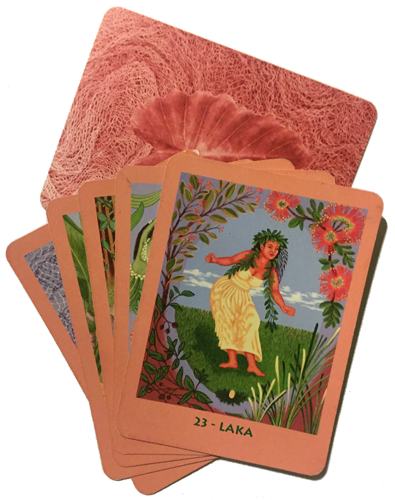About
WHAT ARE MANA CARDS?
 Each of the 44 cards has an English name, an image that symbolizes its essence (surrounded by its various forms), a brief chant that activates its message, a teaching, and an interpretation. There are forty-four cards because the number four and multiples of four were considered sacred by ancient Hawaiians. The sacred invites you to transcend the realm of the ordinary in order to gain a new perspective. In this regard, Mana Cards are a sacred tool for divination, the process of interpreting symbols, to discover hidden knowledge about yourself and the world around you.
Each of the 44 cards has an English name, an image that symbolizes its essence (surrounded by its various forms), a brief chant that activates its message, a teaching, and an interpretation. There are forty-four cards because the number four and multiples of four were considered sacred by ancient Hawaiians. The sacred invites you to transcend the realm of the ordinary in order to gain a new perspective. In this regard, Mana Cards are a sacred tool for divination, the process of interpreting symbols, to discover hidden knowledge about yourself and the world around you.One way the Hawaiians expanded their consciousness was through the use of language. Hawaiian culture has a strong oral tradition that includes stories, songs, and chants that are rich with hidden meanings called kaona. The hidden meaning of a word or expression, its kaona, can be discovered by breaking words into its root syllables, combining the syllables, and examining the meanings.
Taro cultivation (spelled and pronounced kalo in Hawaiian) was very important in ancient Hawaiian culture. Taro was one of the main sources of food in the Hawaiian diet and is one of the most nutritious foods known. Every part of the plant is used, including the starchy tuber which is used to make poi. Nearly 300 different kinds of taro have been identified in Hawai'i. However, due to over development and the impact of other cultures, today fewer than 400 acres of taro are being cultivated in Hawai'i. The scarcity of taro cultivation in the islands symbolizes the loss of a way of life that facilitates a harmonious relationship between people and the earth.
The relationship of humans, land, and taro is discussed in the Hawaiian creation chant, Kumulipo. The chant says that Papa and Wakea, the earth-mother and sky-father, gave birth to the islands, the first taro plant, and the first human. Therefore, ancient Hawaiians believed that taro was their older sibling. The heart-shaped leaves of the taro plant symbolize the important connection humans have with taro, one another, and the earth. Taro cultivation is a way of caring for the land and replenishing Hawaiian culture. It is an example of aloha 'aina, which means "love of the land."
'Aloha 'aina assures humans that the earth will care for them just as they care for her. Ancient Hawaiians gave the earth and the taro the same care and respect they offered to their elder family members, for that is exactly what she was, and still is. Like an elder family member, the earth offers her wisdom to those who are willing and open enough to receive it. The source underlying the wisdom of Hawaiian culture is the same source that inspired the creation of the Mana Cards. You may connect with this source through the cards or directly. That source is in the spirit of Hawai'i Nei. You can find it in her skies, her lands, her waters. You can find it in her fish, birds, animals, and plants. You can find it in her caretakers and teachers, past and present. It is to that source that this work is offered.

